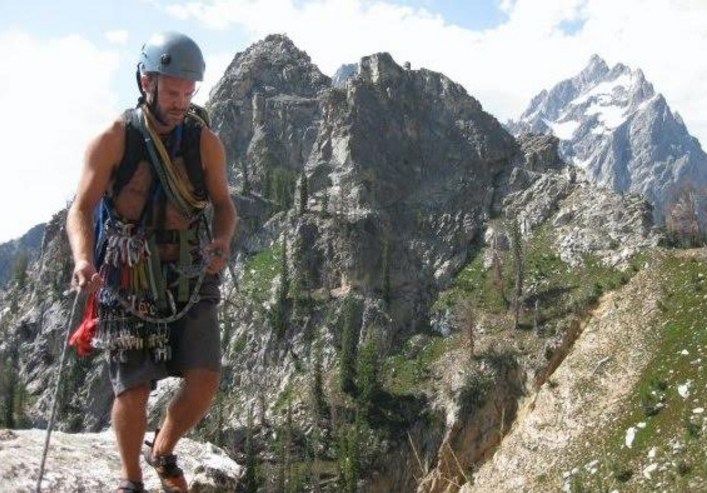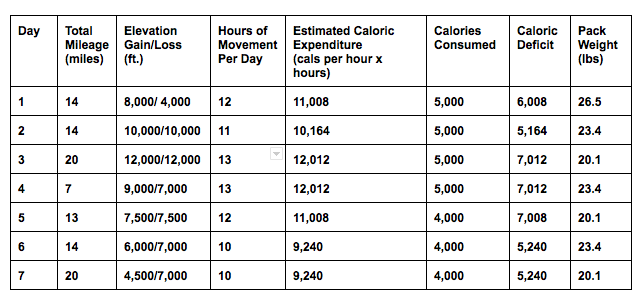
by Colin Montgomery
Background:
Ryan Burke our 2016 Crux Award Winner, will be completing an entire traverse of the Teton Range in mid August. Ryan’s event will last 7 days and cover 102 miles and over 100,000 ft of elevation gain/loss.
As part of programming for Ryan’s Teton Traverse, we’re developing a nutrition and meal plan that would meet his caloric needs as well as being as light as possible in his pack.
Caloric Demand Per Hour:
In order to understand the physiological demands of this event as well as Ryan’s capabilities, earlier this summer we equipped him with a Suunto Ambit3 Heart Rate Monitor/GPS/Accelerometer and recorded physiological data while he completed a 3.5 hour car to car climb of the Grand Teton. This trip involves 14 miles of hiking/running and 7,500 vertical ft of gain/loss. Ryan accomplished what takes many two days to do in 3.5 hours.
Using Ryan’s Grand Teton trip data, and metabolic equations developed by the American College of Sports Medicine (ACSM), we attempted to determine Ryan’s caloric expenditure and caloric expenditure per hour for a fast alpine ascent. The Equations we used are below:

Using these equations and the vertical gain, mileage, and time of Ryan’s car to car Grand Teton trip we were able to determine he expended 2,488 calories for the uphill portion of the trip.
This total does not include downclimbing. We are assuming that downclimbing will be easier and require a lower caloric demand compared to uphill climbing. We are adding 30% of the total caloric demand to the total calories to account for the calories expended during downclimbing.
This new total caloric expenditure for Ryan’s Grand Trip comes to 3,234 calories or roughly 924 calories per hour.
Teton Traverse Breakdown
Below are the exact distances and elevation changes for Ryan’s Teton Traverse as well as how many calories he is likely burning for those days. Ryan plans to complete the traverse over 7 days.
Ryan’s base pack weight will be 17 pounds, not counting food. The pack weight listed below includes this 17 pound base weight, plus weight for food and supplements like gels.

One concern we have is that Ryan’s Grand Teton car to car trip may not reflect the pace or intensity of his Teton Traverse days. Specifically, Ryan has climbed the Grand Teton multiple times, knows the route well, and much of the trip is on established trails. Conversely, he will be route finding for much of the Teton Traverse, and be moving over technical terrain he’s not as familiar with. We assume he’ll be moving slower, and not at such a high intensity.
We are conducting further testing on Ryan this weekend as he will be doing a scouting trip with days of similar exertion and time domain. We hope this data will help us come up with a more accurate caloric expenditure for Ryan’s movement during the Teton Traverse.
Back to the chart above …. You’ll see that with the current equation, Ryan will be in caloric deficit for much of the trip. Food is heavy, and it’s our goal to limit the weight of food he carries to approx. 3.2 pounds/day. With that weight limit, we hope to pack in 4,000 – 5,000 calories per day in food and supplements.
Based on this predicted caloric deficit, we could expect Ryan to lose 12.18 lbs during this traverse. This likely is too much. Ryan currently weighs approximately 150 pounds with sub 6% bodyfat.
We’re hoping Ryan’s trip this weekend will give us a lower calorie per hour number to work with, and that we’ll be able to find calorically dense food for him to consume and carry. More below ….
Nutritional Considerations
For multi-stage endurance event like Ryan’s we had to consider the best way to get the most calories for the lightest weight. We approached this by researching what are the most calorically dense meals, bars, and supplements currently on the market. Once we came up with the best way to get Ryan the calories he needs we needed to ensure that Ryan was getting the proper amounts and proportions of macronutrients and micronutrients. We’re still developing his menu, and we’re using the rules below to guide us:
- Research currently indicates humans can absorb roughly 200-350 calories/60-80g of Carbohydrate per hour and roughly 500ml of fluid. For this event we have Ryan consuming 325 calories per hour. We also are having him consume 500 ml of fluid per hour.
- Meals would be based on 3:1 Carbohydrate to Protein Ratio.
- Ryan’s calories would be broken down into these percentages of macronutrients-65% Carbohydrate, 20% Fat, 15 % Protein. These values differ based on the source we went with the most commonly accepted strategy.
- Ryan will be sweating anywhere from 1-1.5L per hour losing roughly 920 mg of sodium per L of sweat. Via snacks and a energy mix supplement we will have Ryan consume 420 mg of sodium per hour. We understand that he will be in a sodium deficit during activity. This amount of sodium will maintain his electrolyte balance during activity and prevent cramping or decreased performance.
- These caloric expenditures only take into account the calories utilized for the actual events.This doesn’t include the calories he is utilizing to maintain homeostasis (Basal Metabolic Rate), and the calories he is burning while moving and sleeping at altitude.
- Ounces=Pounds, Pounds=Pain. Ryan needs to be moving as light as possible to ensure efficiency of movement.
Things We Still Don’t Know:
There are many questions we are still working to answer in order to create a more complete nutritional plan for Ryan. Here are just a few?
1. Ryan will be traveling over a variety of terrain. The formula above does not take into account that over technical terrain he may be working harder to sustain a slower pace. Can we account for this?
2. During a multi-stage event like this, Do we need to increase his daily calories on day 4, 5, 6, 7, to account for the fact that the previous few days have been 12 hour days and he will be operating at a caloric deficit? Is there a formula to help determine this?
3. The perfect menu and supplementation strategy on paper may not sit well with Ryan’s stomach. How can we test this before his trip?
Tune back in next week to read on the exact meal plan we prescribed for Ryan as well as a more in-depth description of Sports Nutrition and how we applied these to Ryan’s Traverse.
Thanks for reading! Questions/Feedback/Suggestions?
Email Colin, Colin@Mtntactical.com
Teton Traverse Nutrition: Part 2 HERE
STAY UPDATED
Sign-up for our BETA newsletter. Training tips, research updates, videos and articles - and we’ll never sell your info.
